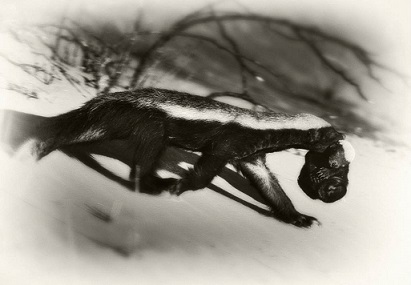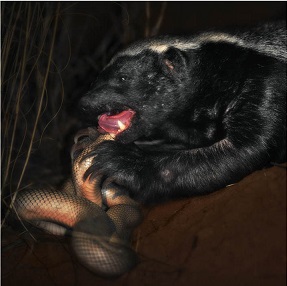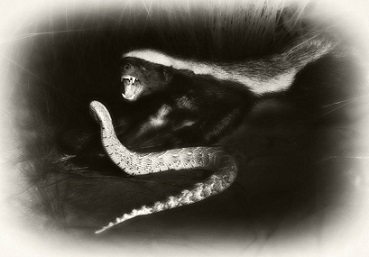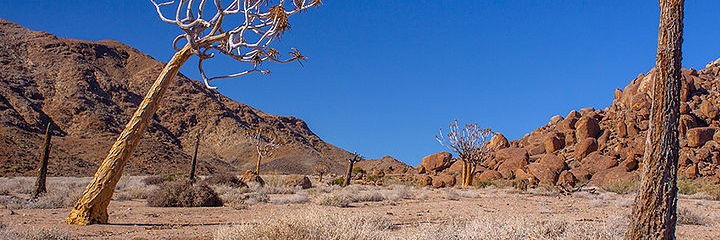Adaptations of the Honey Badger
A great deal of what makes the honey badger such a unique and
effective predator is its physical characteristics. So many
features found in the honey badger are found in few, if any
other mustelidae. It’s far more tough, vicious, and dangerous
than other badgers and such. This unique morphology, which is
due in part to the environment that Mellivora capensis resides
in, has led to the honey badger being one of the most effective
and stable predators in the Kalahari desert.

Starting with the body of the honey badger, it’s apparent that
it’s significantly longer than other mustilidae. In fact, it holds
the title of being the largest mustelid in the Kalahari, and even
the the largest in all of terrestrial Africa (Rosevear, 1974). Its
body is generally thick and long, and broad across its back. Its
head has very recessed ears to be a better fighter and avoid harm
(Kingdon 1989). Combine that with generally thick and loose skin,
and it makes for an excellent predator that is difficult to harm
(Kingdon, 1989). There are many benefits for the honey badger having
this type of skin. The loose skin make the honey badger hard to pin
down, allowing the badger to twist and slip out of the grip of
predators (Rosevear, 1974). Thicker skin around the badger’s neck is
adapted to help when fighting other organisms of the same species
(Kingdon,
1989). In addition, the general thickness and toughness of
the skin aids the honey badger in gathering and
 hunting for food in
the Kalahari Desert. As you may know from other sections of our
website, the honey badger’s name comes from its affinity to honey
from bees. While many believe that this name comes soley from it's
diet of honey, the honey badger actually favors the bee larva more. When a honey badger decides it wants some
larva, it
simply sticks its head into the hive and begins eating. Its skin is
too thick and hardy for most bees to actually land a sting, so a
honey badger will have to endure only a few possible stings to get a
meal of honey. The honey badger has another unique adaptation to
help with getting it its precious honey. They also possess an anal
pouch which can be used defensively or for scent-marking (Begg, et
al. 2006). When searching a hive, the badger will release a scent to
help calm the aggravated bees (Rosevear 1974).
hunting for food in
the Kalahari Desert. As you may know from other sections of our
website, the honey badger’s name comes from its affinity to honey
from bees. While many believe that this name comes soley from it's
diet of honey, the honey badger actually favors the bee larva more. When a honey badger decides it wants some
larva, it
simply sticks its head into the hive and begins eating. Its skin is
too thick and hardy for most bees to actually land a sting, so a
honey badger will have to endure only a few possible stings to get a
meal of honey. The honey badger has another unique adaptation to
help with getting it its precious honey. They also possess an anal
pouch which can be used defensively or for scent-marking (Begg, et
al. 2006). When searching a hive, the badger will release a scent to
help calm the aggravated bees (Rosevear 1974).
Another impressive feature that the honey badger possesses is its
feet and claws. Though its back claws are nothing to scoff at, it
becomes clear how fit of a predator the honey badger has become when
one observes it’s long front claws. The front claws average around
38mm and grow throughout its life. Its wide palms and long claws
specialize in running along the loose sand, allowing the Honey
Badger to chase prey effectively without losing its footing. Honey
badgers live in burrows that they dig into the sand themselves, and
these claws certainly come in handy when it comes to making itself a
home. These burrows are usually one to three meters long,
comfortably accommodating the badger’s 55-77cm body. Because of its
incredibly strong claws, the Honey Badger can dig these tunnels in
as little as ten minutes (Heptner, 2002). Sometimes, instead of
making a burrow, the honey badger will use the lengthy front claws
to search one. They dig rodents and other small, burrowing animals
out of their burrows for food. These burrowing animals are plentiful
in all the areas where the Honey Badger lives.
when it comes to making itself a
home. These burrows are usually one to three meters long,
comfortably accommodating the badger’s 55-77cm body. Because of its
incredibly strong claws, the Honey Badger can dig these tunnels in
as little as ten minutes (Heptner, 2002). Sometimes, instead of
making a burrow, the honey badger will use the lengthy front claws
to search one. They dig rodents and other small, burrowing animals
out of their burrows for food. These burrowing animals are plentiful
in all the areas where the Honey Badger lives.
Lastly, we can’t forget the business end of the honey badger’s predatory success, its teeth. It’s hard to get consistent data on the finer details of the honey badgers teeth due to the teeth degrading over time with use. Some instances of this degradation are some teeth being exceptionally worn down, or crooked (Rosevear 1974). The small, but incredibly sharp teeth combined with strong jaws make the honey badger a unique predator worth learning about.
To see how these adaptations are put to use, check out the honey badger's Nutrition page.
